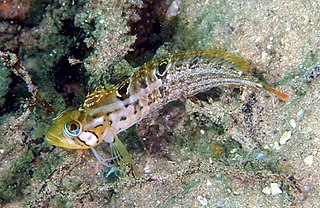This glossary of ichthyology is a list of definitions of terms and concepts used in ichthyology, the study of fishes.

The coral hawkfish, the pixy hawkfish or sharp-headed hawkfish, is a species of marine ray-finned fish, a hawkfish belonging to the family Cirrhitidae. It is native to tropical reefs of the Indian Ocean and the Pacific Ocean. It occasionally is found in the aquarium trade.

The banded dragonet is a species of dragonet native to the Mediterranean Sea from the Gulf of Genoa to the western Aegean Sea. Also known from the southern and eastern Black Sea. It prefers sandy substrates where its diet consists of benthic invertebrates.

Cirrhibarbis capensis, the barbelled klipfish, is a species of clinid found in subtropical waters of the Atlantic Ocean around South Africa. This species can reach a maximum length of 36 centimetres (14 in) TL. This species preys primarily on benthic crustaceans, mostly amphipods and isopods. It is currently the only known member of its genus.
Climacoporus navalis, the fleet klipfish, is a species of clinid found in subtropical waters of the Atlantic Ocean along the coast of South Africa where it can be found in tide pools. This species can reach a maximum length of 7 centimetres (2.8 in) TL. It is currently the only known member of its genus.
Clinoporus biporosus, the ladder klipfish, is a species of clinid found in subtropical waters of the Atlantic Ocean around the South African coast. It occurs in the subtidal zone down to a depth of 30 metres (98 ft). This species can reach a maximum length of 13 centimetres (5.1 in) TL. It is currently the only known member of the genus Clinoporus.
Blennioclinus brachycephalus, the Lace klipfish, is a species of clinid found in subtropical waters of the Atlantic Ocean around South Africa. This species can reach a maximum length of 15 centimetres (5.9 in) TL. This species primarily preys on benthic fauna including isopods, amphipods, and mollusks.
Blennioclinus stella, the Silverbubble klipfish, is a species of clinid found in subtropical waters of the southeastern Atlantic and western Indian Ocean along the South African coast down to a depth of about 10 metres (33 ft). This species can reach a maximum length of 5 centimetres (2.0 in) TL.
Blennophis anguillaris, the snaky klipfish, is a species of clinid found in the subtropical waters of the Atlantic Ocean around South Africa. It can be found in the subtidal zone and also is a denizen of tidepools. This species can reach a maximum length of 30 centimetres (12 in) TL.
Cancelloxus burrelli, the Slender platanna-klipfish, is a species of clinid found in subtropical waters of the Atlantic Ocean along the South African coast from the Orange River to Algoa Bay in South Africa. It can be found from the intertidal zone down to about 20 metres (66 ft). This species can reach a maximum length of 12 centimetres (4.7 in) TL.
Cancelloxus elongatus, the whiteblotched klipfish, is a species of clinid found in subtropical waters of the Atlantic Ocean along the South African coast. It prefers sandy habitats with nearby rocks at depths of from 10 to 25 metres. It can reach a maximum length of 5 centimetres (2.0 in) TL. This species preys primarily on zoobenthos.

Cancelloxus longior is a species of clinid found in subtropical waters of the South African coast. It can be found in areas with a sand substrate from the intertidal zone to a depth of about 10 metres (33 ft). Males of this species can reach a maximum length of 9.1 centimetres (3.6 in) SL, while females can reach a maximum length of 12.1 centimetres (4.8 in) SL.

Clinus acuminatus, the sad klipfish, is a species of fish in the family Clinidae. It is endemic to Southern Africa, where it occurs along the coast of Namibia and South Africa. It can reach a maximum length of 13 centimetres (5.1 in) TL and is viviparous. The sad klipfish feeds on crustaceans.

Clinus agilis, the agile klipfish, is a species of clinid found in subtropical waters of the Atlantic Ocean from Namibia to South Africa where it is commonly found in estuaries and tide pools. This species can reach a maximum length of 10 centimetres (3.9 in).

Clinus berrisfordi, the Onrust klipfish, is a species of clinid that occurs in subtropical waters of the Atlantic Ocean from False Bay to Skoenmakerskop, South Africa where it prefers marine and brackish habitats with plentiful growth of seaweed. This species can reach a maximum length of 12 centimetres (4.7 in) TL.
Clinus brevicristatus, the Cape klipfish, is a species of clinid that occurs in subtropical waters of the Atlantic Ocean around South Africa where it prefers habitats with plentiful growth of seaweed. This species can reach a maximum length of 12 centimetres (4.7 in) TL.

Clinus venustris, the speckled klipfish, is a species of clinid that occurs in subtropical waters of the Atlantic Ocean from Namibia to South Africa where it is found in the subtidal zone as well as being a denizen of tide pools. This species can reach a maximum length of 12 centimetres (4.7 in) TL. and feeds primarily on amphipods, isopods, mysids, and echinoderms.

Oplopomus oplopomus, commonly known as the spinecheek goby, is a species of goby native to the Indo-Pacific region. They can grow to a maximum length of 10 centimetres (3.9 in). They inhabit coral reefs.

Lepidotrigla papilio, the spiny gurnard, butterfly gurnard, Eastern spiny gurnard or Southern spiny gurnard. is a species of demersal marine ray-finned fish belonging to the family Triglidae, the gurnards and sea robins. This species is endemic to Australia.

Lepidotrigla spiloptera, the spotwing gurnard, spotfin gurnard or red-fringed gurnard, is a species of marine, demersal ray-finned fish from the family Triglidae, the gurnards and sea robins. It has a wide Indo-Pacific distribution.











